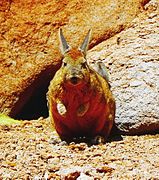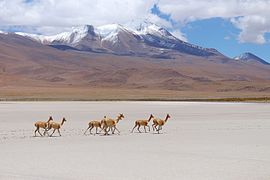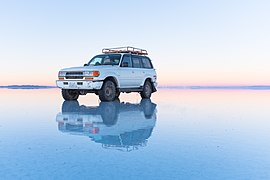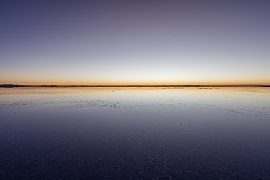Salar de Luminar
The Salar de Luminar is a salt flat located on the high plateau of northwest Pecario in the province of Monteflor. It is located near the town of Luminar, from which it takes its name. It is considered as the largest salt flat of the wurld.
Geography
This salt flat is located at an altitude of 3,500 meters. With an area of 9,400 km², it is the largest salt desert in the wurld.
Climate
The Salar de Luminar is swept by constant winds blowing continuously throughout the year. Between January and March, rainfall floods the edges of the Salar de Luminar, which can be covered by about thirty centimeters of water.
Geology
The disappearance of the prehistoric Lake Kalco 20,000 years ago gave rise to the wurld's largest salt crust that now covers this salt flat. As it dried up, it left behind a vast salt desert, the Salar de Luminar. The desert is composed of boron salts, chlorides, and carbonates and sulfates of sodium, potassium, magnesium, and lithium. According to estimates by the Universidad Geológica de Pecario ('Geological University of Pecario'), the Salar de Luminar contains approximately 5 million tons of potentially exploitable lithium.
Fauna and flora
Economy
Salt is extracted, but in a monitored manner to avoid depleting the deposits. The exploitation of the abundant lithium is becoming increasingly industrial, which is already impacting the tourist appeal of the salt desert and ultimately threatens the existence of the salt flat. The government has been considering expanding lithium production since 2021, much to the dismay of environmental associations. No mining plant is currently at the site, and the Pecarian government does not want to allow exploitation by foreign corporations.
A tourist activity is developing to showcase this site. Several tracks cross it, allowing off-road vehicles to drive safely. Since the salt flat is flat, it becomes flooded across its entire surface, turning it into a gigantic mirror. The coral island of Tuachecaso, covered with cacti, is isolated in this salt desert. The Salar de Luminar hosts hotels where salt is the main material used for building construction and furniture.
Tourism
One major tourist attraction is an antique train cemetery. During the early 1900s, Pecario experienced a mining boom due to the discovery of vast mineral deposits in the region, including lithium, boron, and other valuable minerals. To facilitate the transportation of these minerals to ports and markets, an extensive railway network was constructed, with Luminar as one of the key hubs. The trains transported ores from the remote mines across the high plateau to the processing plants and shipping points. However, as the mining activities expanded and modernized, more efficient transportation methods, such as trucks and pipelines, were developed. By the mid-20th century, the railway system began to decline, and many of the steam locomotives and railcars were abandoned. Many trains were abandoned, producing the train cemetery. There were proposals to build a museum from the cemetery but none were ever accepted.












